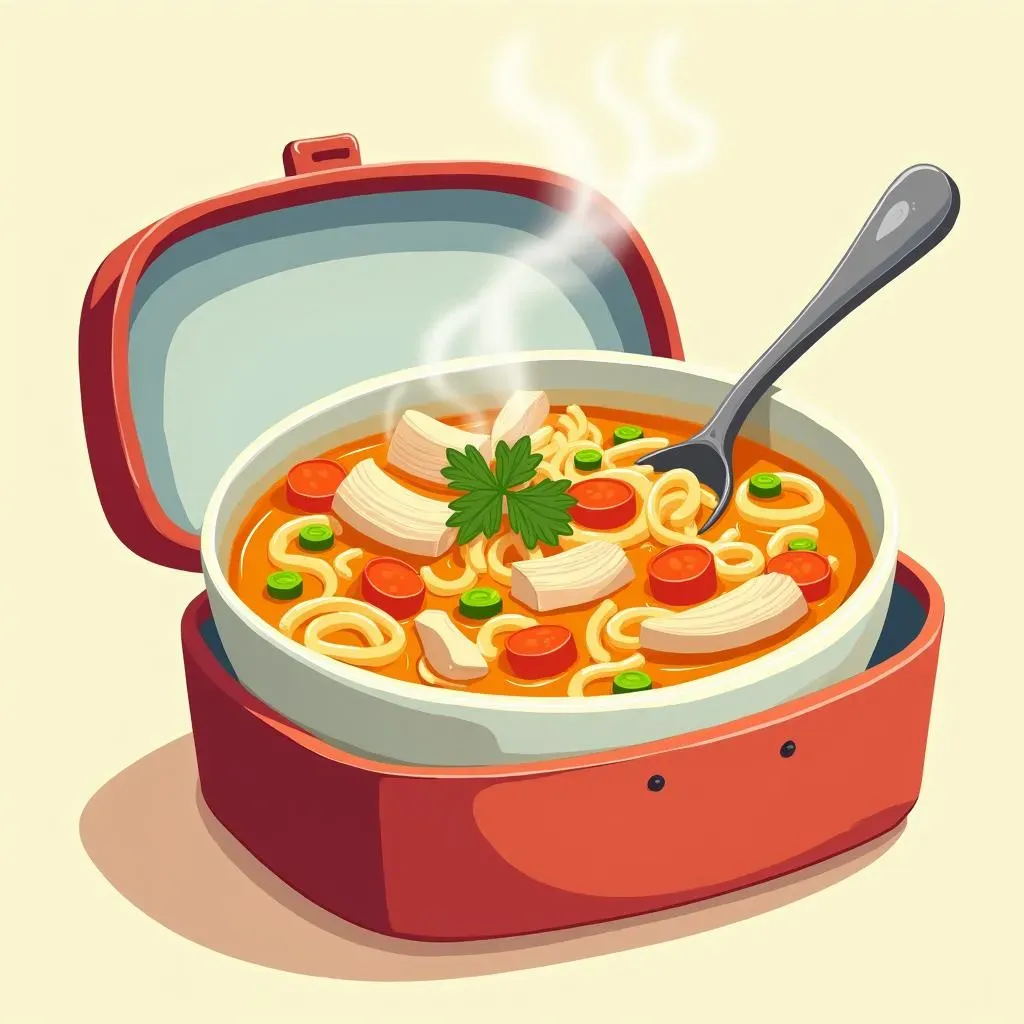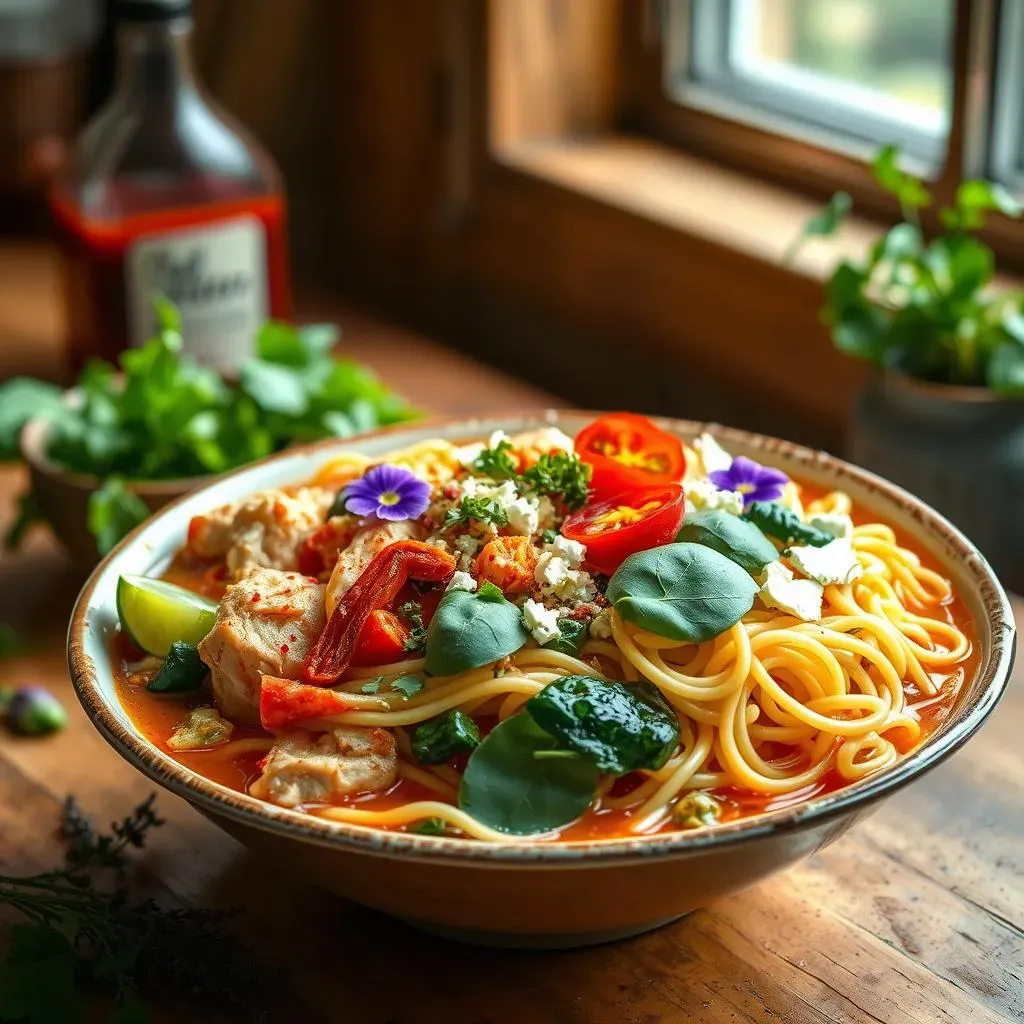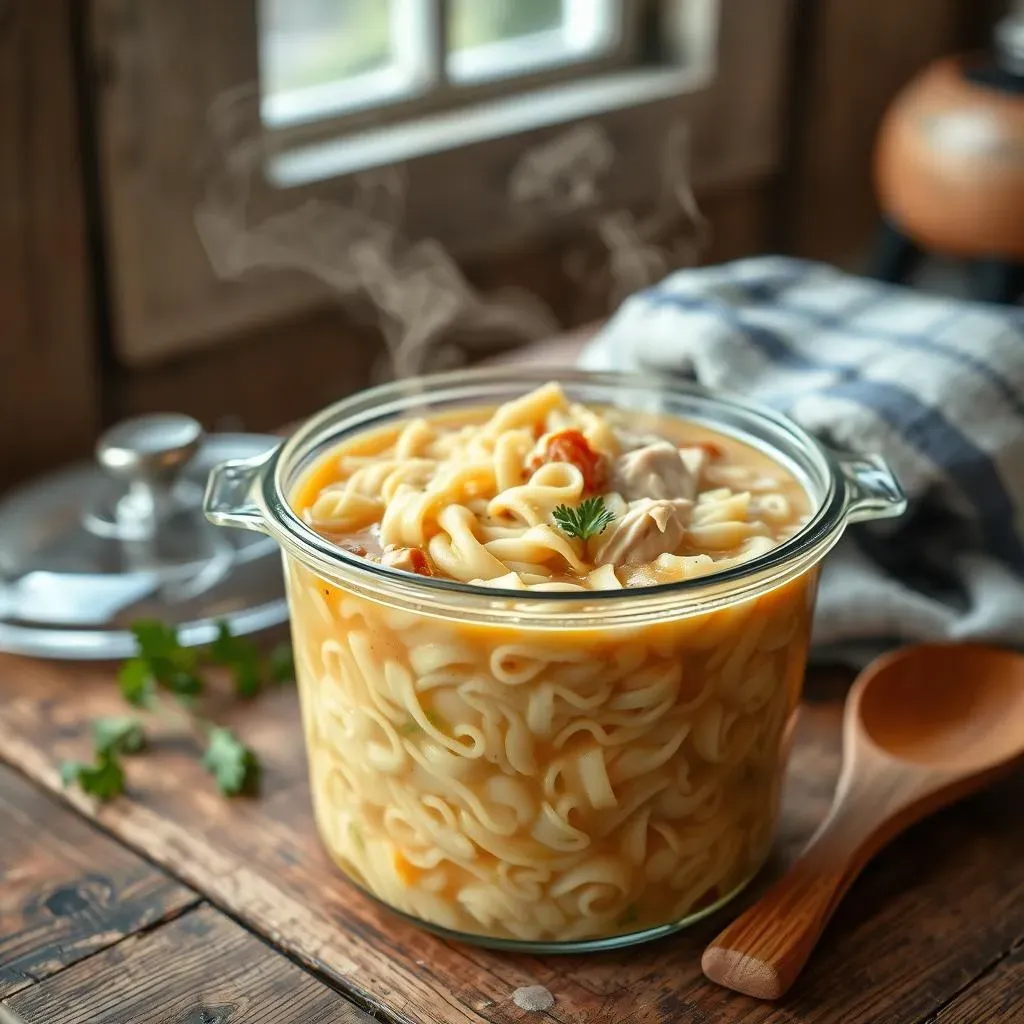Table of Contents
Ever wished you could send your kids to school with a warm, comforting hug in their lunchbox? Well, you can! Forget those boring sandwiches; let’s talk about the magic of chicken noodle soup for lunchboxes. It's not just about packing a meal; it’s about sending a little bit of home with them. This classic soup is a powerhouse of nutrients, tastes delicious, and is surprisingly easy to pack. We'll walk you through creating the perfect batch of chicken noodle soup, focusing on how to make it lunchbox-friendly. From cooking tips to clever packing methods, we've got you covered. We will even look at some fun variations to keep things interesting and how to store your soup safely for the week. Get ready to become a lunchbox hero, one spoonful of soup at a time. So, grab your apron, and let's get cooking!
Making the Perfect Chicken Noodle Soup for Lunchboxes

Making the Perfect Chicken Noodle Soup for Lunchboxes
Okay, so you want to nail this chicken noodle soup thing, right? It's all about building flavor. Don't just chuck everything in a pot and hope for the best. Start by sautéing some finely chopped onions, carrots, and celery – that's your flavor base. Let them sweat a little, until they're soft and fragrant, before adding in some garlic, for about a minute. Then, toss in your chicken. I like using boneless, skinless chicken breasts or thighs, because they’re quick to cook and easy to shred later. Next, the magic liquid: good quality chicken broth. You can use stock too, if you have it, but the broth is just fine. Season it well with salt and pepper, and a dash of herbs like thyme or rosemary. And don't forget a bay leaf! It’s a small thing but it makes a big difference. Now, let it simmer gently until the chicken is cooked through.
Once the chicken is cooked, take it out and shred it with two forks. I like shredding it kind of small so it's easy to eat with a spoon. While the chicken is out, add your noodles to the broth. Egg noodles are classic, but you can use any kind you like - rotini, macaroni, whatever floats your boat. Cook them according to the package instructions. Remember, you don't want them to be mushy by the time it's lunch. Once the noodles are done, add the shredded chicken back in. Give it a good stir and taste. Does it need more salt? A little squeeze of lemon? Don’t be shy to adjust it to your taste. Finally, remove the bay leaf. Now you have a delicious, flavorful, and perfectly balanced chicken noodle soup that's ready for its lunchbox debut.
Ingredient | Why It Matters |
|---|---|
Onions, Carrots, Celery | Creates the flavor base |
Garlic | Adds depth and aroma |
Chicken Breast/Thighs | Provides protein and is easy to shred |
Chicken Broth | The liquid base for the soup |
Herbs (Thyme, Rosemary) | Enhances the flavor profile |
Bay Leaf | Adds subtle complexity |
Egg Noodles | Classic noodle choice, but use any you prefer |
Tips for Packing Chicken Noodle Soup for Lunchboxes

Tips for Packing Chicken Noodle Soup for Lunchboxes
Choosing the Right Container
Okay, let's talk containers, because this is where things can go very, very wrong. You can't just toss soup into any old box and hope for the best. A good thermos is your best friend here. Not those flimsy ones that barely keep coffee warm for an hour, but a proper insulated food jar. Preheating the thermos is crucial; pour boiling water into it while you're getting the soup ready. Then, when it's time to pack, dump out the water and fill it with your hot soup. This will keep it warm for hours. And for the love of all that is holy, make sure the lid is on tight. Nobody wants a soggy backpack.
Another thing to consider is the size of the container. You want it to be big enough to hold a good serving of soup but also small enough to fit comfortably in a lunch bag. I usually go for something around 10-12 ounces. Also, think about the opening. A wide mouth thermos is easier to fill and clean, especially if the soup has chunky bits. And don't forget to pack a spoon! I can't tell you how many times I've seen kids trying to eat soup with a fork, and it's not a pretty sight. So, thermos, preheated, right size, wide mouth, tight lid, and don't forget the spoon. Got it?
Preventing Leaks and Spills
Alright, so you've got your awesome thermos. But what about backup? Because let's be real, even the best containers can sometimes fail. I like to wrap the thermos in a plastic bag, just in case. It’s like a safety net for your lunch bag. And always, always pack it upright. Don't just toss it in sideways hoping for the best. Treat it like it contains liquid gold, because, well, it kind of does. When packing the lunch bag, make sure the soup container isn’t being squished by other items. A sturdy lunch bag helps with this. Think of it like a little fortress for your soup.
Another tip is to pack the soup separately from other items that might get soggy if there’s a leak. For example, don't put the thermos right next to a bag of crackers or a delicate sandwich. Keep the wet stuff away from the dry stuff. This also prevents any cross-contamination of flavours. No one wants a sandwich that tastes like chicken noodle soup. And finally, if you’re using a container with a screw-on lid, double check that it is screwed on properly. I know it sounds obvious, but trust me, it’s often the simple things that trip us up. So, safety first, always.
Packing Tip | Why It Matters |
|---|---|
Preheat the thermos | Keeps the soup warm longer |
Use a wide-mouth thermos | Easier to fill and clean |
Wrap the thermos in a plastic bag | Provides extra leak protection |
Pack the thermos upright | Prevents spills |
Pack separately from dry items | Avoids soggy lunches |
Double-check the lid | Ensures a tight seal |
Creative Chicken Noodle Soup Variations

Creative Chicken Noodle Soup Variations
Spice It Up!
Alright, let's get adventurous! Chicken noodle soup doesn't have to be the same old thing every time. How about we add a little kick? A pinch of red pepper flakes can do wonders. Or, if you're feeling really bold, a dash of hot sauce. Sriracha or Tabasco will do the trick, but go easy on it, you can always add more. You can also try adding some curry powder for a more exotic flavor. Start with a small amount and taste as you go. Don't be afraid to experiment, that’s how you discover new favorites! These little tweaks can turn a classic soup into something totally different.
Another way to spice things up is by adding different kinds of peppers. A chopped jalapeno will give it a nice, subtle heat, while a poblano pepper will add a smoky flavor. Remember to remove the seeds and membranes if you don’t want it too spicy. And for a flavor boost, consider adding some fresh ginger. Grate a small piece and toss it in while the soup is simmering. It’ll add a warm, zesty note that's so good. These changes are simple, but they can make a big difference in the overall taste. It's like giving your soup a personality makeover!
Go Global with Flavors
Let's take a trip around the world with our soup, shall we? Instead of traditional herbs, try adding some Asian-inspired flavors. A splash of soy sauce or tamari will give it an umami punch. Add some grated fresh ginger and a clove of garlic for an extra boost. A squeeze of lime juice at the end will brighten things up. You can also add some chopped cilantro for a fresh, herbal note. And if you want some crunch, sprinkle some toasted sesame seeds on top before serving. It's like a mini vacation in a bowl.
Or, how about a Mediterranean twist? Add some sun-dried tomatoes and a handful of spinach during the last few minutes of cooking. A dollop of pesto on top before serving will add a burst of fresh flavor. You can also add some artichoke hearts for a bit of texture. Feta cheese crumbles are another great topping for a Mediterranean-inspired soup. These variations show that chicken noodle soup is incredibly versatile and can be adapted to suit any taste. You can easily make it your own by adding your favorite ingredients.
Variation | Flavor Profile | Key Ingredients |
|---|---|---|
Spicy Kick | Warm and Piquant | Red pepper flakes, hot sauce, jalapeno |
Asian Fusion | Savory and Zesty | Soy sauce, ginger, lime, cilantro |
Mediterranean Twist | Fresh and Herbaceous | Sun-dried tomatoes, spinach, pesto, feta |
Storing and Reheating Your Chicken Noodle Soup

Storing and Reheating Your Chicken Noodle Soup
Cooling Down the Soup
Alright, so you've made this amazing soup, but now what? You can't just leave it sitting on the counter all day, right? First things first, let it cool down a bit before you try to store it. I usually let it sit for about 30 minutes to an hour, but not too long. You want it to be cool enough so that it doesn’t create condensation when you put it in the fridge. Never put hot soup directly in the fridge, it can raise the fridge temperature and mess with other stuff.
Once it's cooled down, transfer it to airtight containers. I like to use glass containers because they're easy to clean and don't retain smells, but plastic ones work fine too. Just make sure they're food safe. If you're planning to freeze the soup, leave a little bit of space at the top of the container because liquids expand when frozen. And don't forget to label everything! Write the date on the container so you know when you made it. Trust me, this will save you from playing "mystery soup" in your fridge later on.
Reheating Like a Pro
Okay, so you're ready to eat your soup, yay! If you’re reheating from the fridge, you can do it on the stovetop or in the microwave. If using the stovetop, put the soup in a saucepan and heat it over medium heat. Stir it occasionally to make sure it heats evenly. Don’t let it boil too vigorously, you don’t want to overcook the noodles and make them mushy. If using the microwave, put it in a microwave-safe bowl and heat it in intervals, stirring in between. This will prevent it from getting too hot in some parts and cold in others. Remember, microwaves can be tricky.
If you’re reheating from frozen, it’s best to thaw it in the fridge overnight before reheating. This will help ensure it heats up evenly and the noodles don't get mushy. If you don't have time, you can reheat it from frozen on the stovetop, but it will take longer. Just put the frozen soup in a saucepan and heat over low heat, stirring occasionally. Once the soup is thawed, increase the heat to medium until it’s heated through. And always make sure your soup is piping hot before serving. Nobody wants lukewarm soup.
Reheating Method | Pros | Cons |
|---|---|---|
Stovetop | Even heating, better control | Takes longer, requires more attention |
Microwave | Quick, convenient | Can heat unevenly |
Freezing for Future Lunches
Freezing is a great way to make soup ahead of time. It's a real lifesaver for busy weekdays. As I mentioned before, make sure you leave a little space at the top of the container to allow for expansion. You can also freeze the soup in individual portions, which is great for packing lunches. I like using freezer-safe bags, laying them flat on a baking sheet in the freezer until frozen, this makes them stackable in the freezer.
When you are ready to use the frozen soup, you can thaw it in the fridge overnight, or if you're in a pinch, you can put the frozen block of soup directly in a pot and heat it over low heat until it’s thawed. Don’t forget to stir it occasionally. Frozen soup can last for 3-6 months, but I usually try to use it up within 3 months to maintain the best flavor. Freezing is like a time machine for your soup, ready when you need it!
"The best way to reheat soup is low and slow, it helps maintain the quality and flavor." - Chef Ramsey (Not really, but it sounds good, right?)
